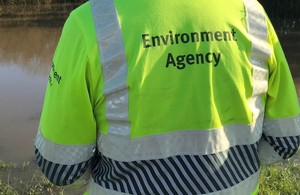Bathing water season in England begins as applications re-open
The Environment Agency will be testing water quality more than 7000 times during the season

The bathing water season has officially started (Thursday 15 May 2025), marking the beginning of rigorous testing of water quality from the Environment Agency at bathing sites.
Our bathing waters bring important social and health benefits to local communities and help coastal towns prosper by attracting tourists from across the UK and the world.
Throughout the season, which runs from 15 May until the end of September, the Environment Agency will be taking more than 7000 samples at 451 designated bathing waters across England.
Today also marks the re-opening of applications for new bathing waters which have been closed since October 2023 and since then, the government has announced significant reforms to the Bathing Water Regulations to better reflect public use of iconic swimming spots. Successful sites will be announced next year.
Environment Agency Chair Alan Lovell said:
We know just how important England’s swimming spots are to people and to local economies, so our teams are out taking regular samples at bathing waters across England from today.
The information from those tests helps us keep people safe, target our regulation and encourage investment to drive up water quality standards. It’s part of our core commitment to protect people and the environment.
We also welcome the opportunity to improve the management of bathing waters through the incoming reforms as we all want to see better bathing water quality.
Water Minister Emma Hardy said:
Our bathing waters across the country are a great source of pride.
That is why this Government is committed to protecting them. Our landmark Water Act includes new powers to ban bonuses for polluting water bosses and to bring criminal charges against them if they break the law.
A record £104 billion in private investment has also been secured to upgrade and build new sewage pipes to help clean up our waterways for good as part of the government’s Plan for Change.
The water samples are tested in labs and then the results are uploaded onto Swimfo, which displays regular information on water quality across all designated bathing waters to help the public make informed choices about where to swim.
After the season has ended, the sample results are used to classify each bathing water as either ‘excellent’, ‘good’, ‘sufficient’ or ‘poor’. Classifications are shown on Swimfo and on signs at the site to inform bathers of typical quality.
This comes alongside applications for new bathing waters which will be assessed against the planned core reforms, set to come into effect later this year, and include changes to designation criteria for future sites.
Prospective applicants are encouraged to submit their applications using the updated guidance to make sure new sites are designated in line with the changes to the Regulations.
Notes to editors:
- Bathing waters are officially designated outdoor swimming sites. England has 451 designated bathing waters, which are monitored and classified by the Environment Agency.
- Applicants are encouraged to use the bathing water season to gather evidence for their applications. Prospective sites will be assessed for their suitability as a designated bathing water. Applications for the 2026 season will close on 31 October 2025.
- Defra has published updated guidance on how to apply for a site to be designated.
- The Environment Agency has driven £2.5 billion of investment and facilitated partnerships to dramatically improve our bathing waters.
- Last year, nearly 92% of bathing waters in England met the minimum water quality standards. More information on 2024 bathing water classifications is available here.
- The UK Health Security Agency and Environment Agency also offer advice in their ‘swim healthy’ guidance, which is available to read before making any decision on swimming.
- Bathing waters are stretches of water throughout England which we monitor for two types of bacteria: E.coli and intestinal enterococci. We monitor for these two bacteria because they indicate that there are germs in the water which can make you ill.